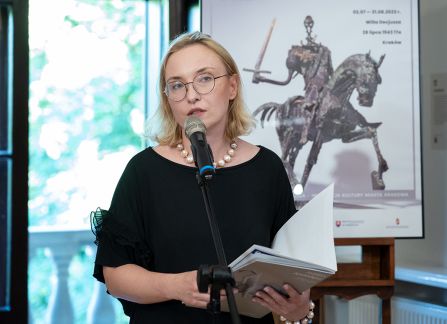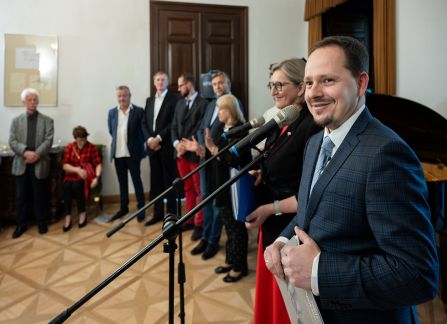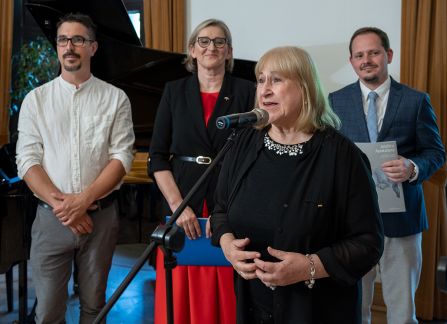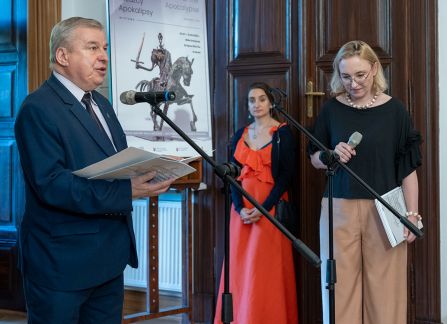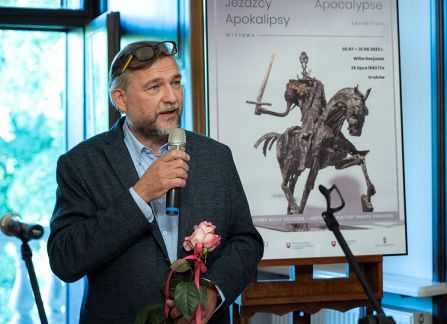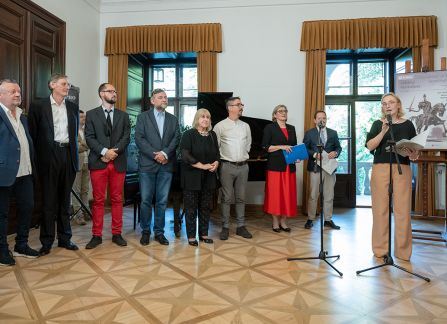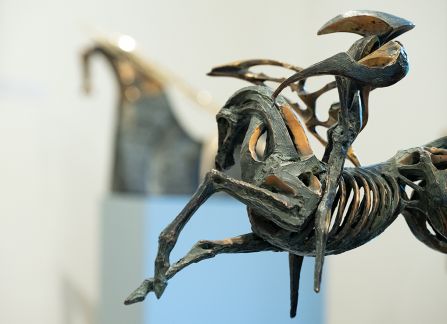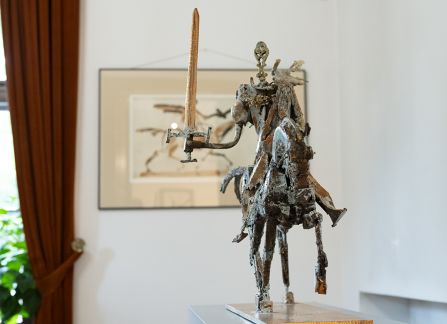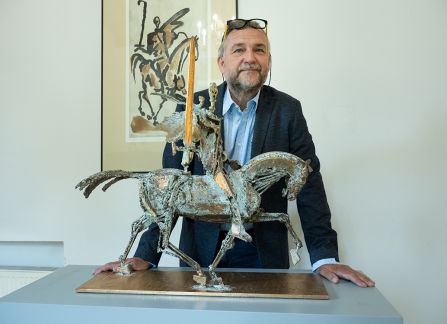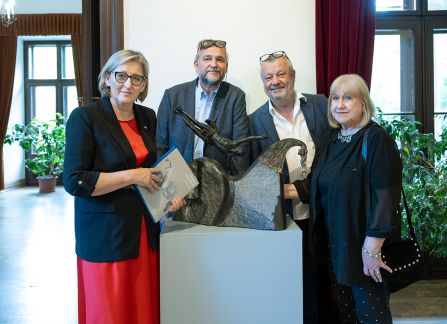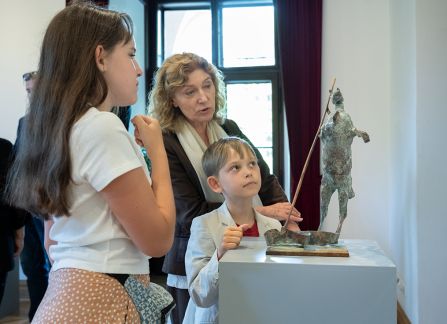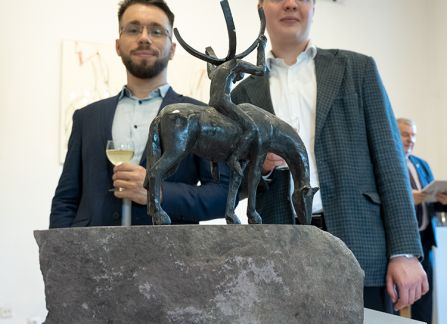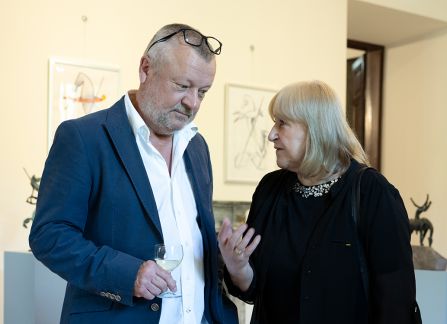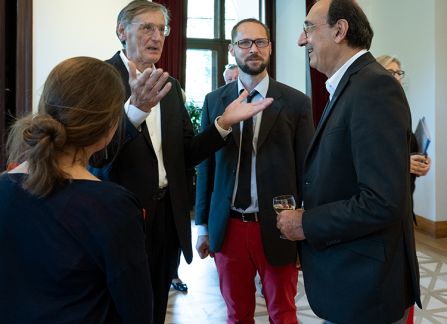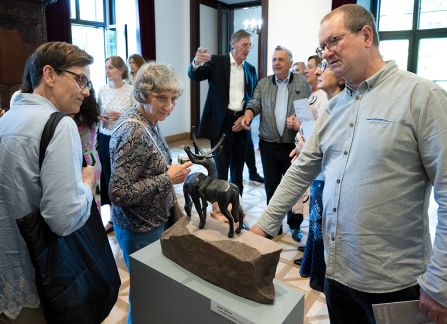Horsemen of the Apocalypse in Villa Decius 22.05.2023
We invite you to the exhibition of sculptures and drawings by Visegrad artists.

From the beginning of July 2023, Villa Decius Institute for Culture hosted an exhibition of sculptures and drawings titled "Horsemen of the Apocalypse."
On the exhibition are presented the works of Visegrad sculptors, according to the project developed by Bronislaw Krzysztof. Bronisław Krzysztof from Poland, Peter Nižňanský from the Czech Republic, Marek Brzózka from Hungary, Milan Lukáč and Vít Bojňanský from Slovakia and Krzysztof Krzysztof from Poland will present their works at the exhibition.
For centuries, the vision of four merciless and menacing warriors galloping through the country and the destruction they bring has been artistically reflected, among others, in the works of anonymous medieval authors, illuminated manuscripts and temple frescoes, as well as in the masterful copperplate engravings of Albrecht Dürer and the paintings of Hieronymus Bosch.
Nowadays, the theme of catastrophe, death, destruction and apocalyptic visions of the future is extremely topical. The well-known Polish sculptor Bronislaw Krzysztof has been devoting much space to this theme in his drawings, medals and sculptures for more than a decade. In 2020, he initiated the Riders of the Apocalypse project, which involved other artists from the Visegrad Four countries: Petr Nižňanského from the Czech Republic, Marek Brzózka from Hungary and Milan Lukáč from Slovakia. Each of them had the task of creating, in drawing and sculpture, their own vision of the image of one of the four apocalyptic horsemen mentioned in the biblical Apocalypse of St John.
This is how fascinating, expressive works of art were created, depicting the horse and rider together with their symbols of apocalyptic doom: the bow, swords and scales.
The authors first presented their works in 2021 in Bielsko-Biała, later in Wrocław and then in Bratislava. For the exhibition at Villa Decius, they are also joined by Slovak sculptor Vít Bojňanský with his creative vision of a horseman, which is a metaphorical complement to the apocalyptic story in its symbolic expressiveness.
The exhibition will be presented in the spaces of Villa Decius from 2 July until the end of August 2023.
The exhibition is an artistic event accompanying the inauguration of the 21st edition of the Visegrad Summer School at Villa Decius.
Partners:
Consulate General of Hungary in Krakow
Consulate General of the Slovak Republic in Kraków
Slovak Institute in Warsaw
On the exhibition are presented the works of Visegrad sculptors, according to the project developed by Bronislaw Krzysztof. Bronisław Krzysztof from Poland, Peter Nižňanský from the Czech Republic, Marek Brzózka from Hungary, Milan Lukáč and Vít Bojňanský from Slovakia and Krzysztof Krzysztof from Poland will present their works at the exhibition.
For centuries, the vision of four merciless and menacing warriors galloping through the country and the destruction they bring has been artistically reflected, among others, in the works of anonymous medieval authors, illuminated manuscripts and temple frescoes, as well as in the masterful copperplate engravings of Albrecht Dürer and the paintings of Hieronymus Bosch.
Nowadays, the theme of catastrophe, death, destruction and apocalyptic visions of the future is extremely topical. The well-known Polish sculptor Bronislaw Krzysztof has been devoting much space to this theme in his drawings, medals and sculptures for more than a decade. In 2020, he initiated the Riders of the Apocalypse project, which involved other artists from the Visegrad Four countries: Petr Nižňanského from the Czech Republic, Marek Brzózka from Hungary and Milan Lukáč from Slovakia. Each of them had the task of creating, in drawing and sculpture, their own vision of the image of one of the four apocalyptic horsemen mentioned in the biblical Apocalypse of St John.
This is how fascinating, expressive works of art were created, depicting the horse and rider together with their symbols of apocalyptic doom: the bow, swords and scales.
The authors first presented their works in 2021 in Bielsko-Biała, later in Wrocław and then in Bratislava. For the exhibition at Villa Decius, they are also joined by Slovak sculptor Vít Bojňanský with his creative vision of a horseman, which is a metaphorical complement to the apocalyptic story in its symbolic expressiveness.
The exhibition will be presented in the spaces of Villa Decius from 2 July until the end of August 2023.
The exhibition is an artistic event accompanying the inauguration of the 21st edition of the Visegrad Summer School at Villa Decius.
Partners:
Consulate General of Hungary in Krakow
Consulate General of the Slovak Republic in Kraków
Slovak Institute in Warsaw
Horsemen of the Apocalypse
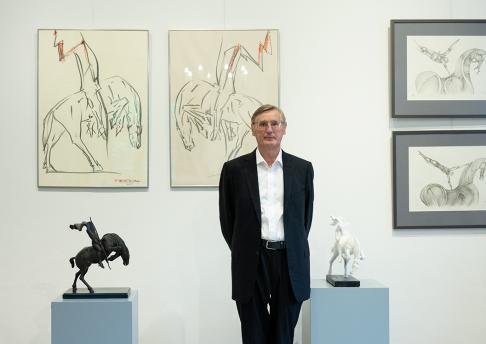
Bronisław Krzysztof
Bronislaw Krzysztof - born in 1956 in Mszana Górna. In 1981 he graduated from the Faculty of Sculpture at the Academy of Fine Arts in Warsaw. He lives and works in Bielsko-Biala, and does chamber and monumental sculpture, medals, drawing, posters and graphics, and also works as a teacher. He worked as a designer at Sisley Cosmetics in Paris for 25 years, and has presented his works at numerous exhibitions at home and abroad. He has received many national and international awards, including a gold medal in 1986 at the VII. Biennale Internazionale del Bronzetto Dantesca in Ravenna, and in 2008 the Gold Cross of Merit of the President of the Republic of Poland. His works are part of many public and private collections.
In 2020 he initiated the exhibition project "Horsemen of the Apocalypse," for which he engaged his colleagues, sculptors from the Visegrad Four countries. Bronislaw Christopher himself focused mainly on the figure of the first horseman of the Apocalypse, who gallops across the country on a white horse, sowing terror and pestilence, while his bow symbolizes the conqueror. The climbing horse, alluding with its realistic morphology to the author's classical bronzes, is captured in an expressive dynamic of movement, but the stylized figure of the helmeted rider with flying plumes, loosely carrying a bow, evokes in its motionless anonymity a chilling sense of total destruction. Bronislaw Christopher also created the figure of the fourth horseman of the Apocalypse - Death sitting on a fawn horse, who with his attacking sword gallops through the ruined country and leaves behind a world of the dead. The white cast and golden sword heighten the effect of this ominous message. The author also captures a similar dynamic silhouette of the horse and rider in his pastel sketches.
In 2020 he initiated the exhibition project "Horsemen of the Apocalypse," for which he engaged his colleagues, sculptors from the Visegrad Four countries. Bronislaw Christopher himself focused mainly on the figure of the first horseman of the Apocalypse, who gallops across the country on a white horse, sowing terror and pestilence, while his bow symbolizes the conqueror. The climbing horse, alluding with its realistic morphology to the author's classical bronzes, is captured in an expressive dynamic of movement, but the stylized figure of the helmeted rider with flying plumes, loosely carrying a bow, evokes in its motionless anonymity a chilling sense of total destruction. Bronislaw Christopher also created the figure of the fourth horseman of the Apocalypse - Death sitting on a fawn horse, who with his attacking sword gallops through the ruined country and leaves behind a world of the dead. The white cast and golden sword heighten the effect of this ominous message. The author also captures a similar dynamic silhouette of the horse and rider in his pastel sketches.
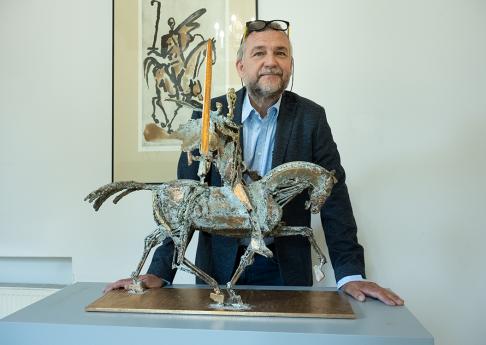
MILAN LUKÁČ
Milan Lukáč - born in 1962 in Bojnice. From 1981 to 1987 he studied at the Higher School of Fine Arts in Bratislava in the department of relief and figurative sculpture, and from 1985 to 1986 at l'École nationale supérieure des Beaux-Arts in Paris. He lives in Bratislava and devotes himself to monumental and intimate sculpture, drawing, painting and graphic techniques. Since 1988, he has been an academic teacher, associate professor and, since 2011, Head of the Institute of Fine Arts and Multimedia at the Faculty of Architecture and Design of the Slovak Technical University. He has participated in numerous exhibitions at home and abroad, his works are represented in the collections of galleries and many important personalities, especially in Francophone countries. He has received several awards for his artistic activity, including the Martin Benka Award (1988), the Paul Louis Weiler Award (1990), and the Prix Itineraire Award (1998).
The figure of the horse was a great challenge for Slovak sculptor Milan Lukáč from his creative beginnings, which he accepted with exceptional nobility. This is also evidenced by one of his early works, which today can be found in the Danubian Museum's permanent exhibition. Ten years later, he created a magnificent equestrian torso of a victorious prince for the Habsburg Jubilee exhibition at Halbturn Castle. Equally consistently, he also focused on the heavenly horseman of the Apocalypse, who was summoned into the world by breaking the second seal on the Book of Life. He galloped on a fiery horse as the personification of war. He has the power to take away the world's peace and unleash mutual slaughter, his fiery horse burns everything that lives and the earth shakes under his heavy hooves. The author depicted him as a victor, scarred from battles, who proudly strides in the pose of a Roman emperor with his sword raised. Visible traces of flame, metal welds and deformed shapes, fragments of found objects embedded in modeled elements, extraordinary pathos and expressiveness of gesture and expression, this is a picture of a demonic figure endowed with power over life and death. Equally impressive are Lukáčove's sculptural sketches made using the monotype technique.
The figure of the horse was a great challenge for Slovak sculptor Milan Lukáč from his creative beginnings, which he accepted with exceptional nobility. This is also evidenced by one of his early works, which today can be found in the Danubian Museum's permanent exhibition. Ten years later, he created a magnificent equestrian torso of a victorious prince for the Habsburg Jubilee exhibition at Halbturn Castle. Equally consistently, he also focused on the heavenly horseman of the Apocalypse, who was summoned into the world by breaking the second seal on the Book of Life. He galloped on a fiery horse as the personification of war. He has the power to take away the world's peace and unleash mutual slaughter, his fiery horse burns everything that lives and the earth shakes under his heavy hooves. The author depicted him as a victor, scarred from battles, who proudly strides in the pose of a Roman emperor with his sword raised. Visible traces of flame, metal welds and deformed shapes, fragments of found objects embedded in modeled elements, extraordinary pathos and expressiveness of gesture and expression, this is a picture of a demonic figure endowed with power over life and death. Equally impressive are Lukáčove's sculptural sketches made using the monotype technique.
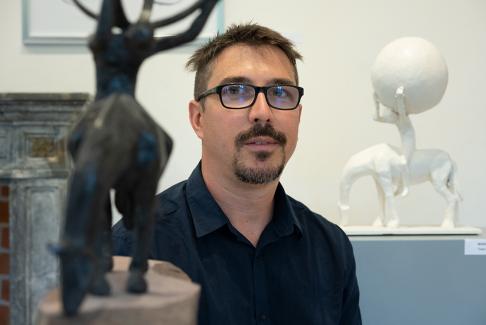
Marek Brzózka
Marek Brzózka - born in 1983 in Segedynia. From 2002-2003 he studied at the István Tomörkény Art Gymnasium, where he specialized in decorative sculpture. In January 2003, he was on scholarship at the Academy of Fine Arts in Krakow. From 2003 to 2008, he studied at the Academy of Fine Arts in Budapest in the figurative sculpture studio. In 2006, as part of the Erasmus program, he had a study stay at the Academy of Fine Arts in Munich. Since 2013, he has continued his doctoral studies at Magyar Képzömüvészeti Egyetem in Budapest. He lives and creates in Segedin, works in monumental and chamber sculpture and drawing, and works as a teacher. He has had numerous solo and group exhibitions and monumental realizations.
Marek Brzózka is a young Hungarian sculptor whose work is mainly inspired by the human figure. The issue of balance, movement and equilibrium plays an important role in his intimate sculptural works. He is also characterized by emphasizing the contrast of different materials, bronze, stone, polychrome ceramics, and especially dense sculptural forms and contours. In the design of Apocalyptic Riders, he chose the symbolic character of Famine, who will rule the world after the third seal is broken. He arrives on a black horse with scales in his hands, accompanied by voices proclaiming the pitifully meager rations of barley and wheat, below the limit of survival. The author depicts him as his black horse calmly "grazes" a depopulated country afflicted by pestilence and war, while the rider, instead of weights, seeks to balance the imaginary burdens of earthly hardships and shortages on his shoulders.
Marek Brzózka is a young Hungarian sculptor whose work is mainly inspired by the human figure. The issue of balance, movement and equilibrium plays an important role in his intimate sculptural works. He is also characterized by emphasizing the contrast of different materials, bronze, stone, polychrome ceramics, and especially dense sculptural forms and contours. In the design of Apocalyptic Riders, he chose the symbolic character of Famine, who will rule the world after the third seal is broken. He arrives on a black horse with scales in his hands, accompanied by voices proclaiming the pitifully meager rations of barley and wheat, below the limit of survival. The author depicts him as his black horse calmly "grazes" a depopulated country afflicted by pestilence and war, while the rider, instead of weights, seeks to balance the imaginary burdens of earthly hardships and shortages on his shoulders.
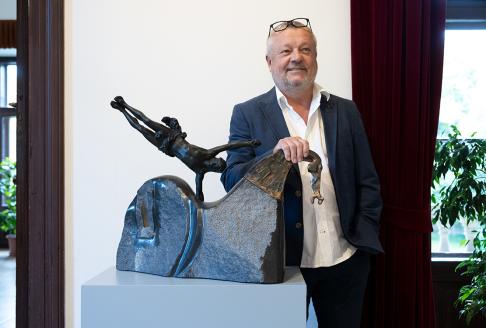
Vít Bojňanský
Vít Bojňanský - born in 1962 in Bratislava. From 1977 to 1981 he studied at the Secondary School of Arts Industry at the Faculty of Woodcarving, and from 1981 to 1987 he studied at the Academy of Fine Arts in Bratislava at the Faculty of Sculpture. He lives and works in Bratislava - Záhorska Bystrica and devotes himself to sculpture and painting and monumental realizations. He has had numerous solo and group exhibitions in Slovakia and abroad, and his works are in many public and private collections. He regularly participates in national and international sculpture symposia.
Vít Bojňanský often combines metal with natural materials in his sculptural work. He also often uses color as a means of expression or as an unexpected accent, with which he emphasizes the meaningful metaphor and symbolism of his sculptures. In 2020 - 2021, he created a collection of intimate and monumental figures of horses, which became for him a symbol of that difficult period, but also his metaphorical defense shield. The beautiful, streamlined shapes of horse bodies made of precious stone, here polished and smoothed, elsewhere left in an unprocessed, vestigial form, the author juxtaposed with the shining bronze necks and heads of climbing and roaring wild horses, symbolizing escape and liberation. Some of these horses remained calm and silent, while others turned into apocalyptic specters. Some of them have abandoned their riders, but still carry raised swords, resembling armed assault drones.
Vít Bojňanský often combines metal with natural materials in his sculptural work. He also often uses color as a means of expression or as an unexpected accent, with which he emphasizes the meaningful metaphor and symbolism of his sculptures. In 2020 - 2021, he created a collection of intimate and monumental figures of horses, which became for him a symbol of that difficult period, but also his metaphorical defense shield. The beautiful, streamlined shapes of horse bodies made of precious stone, here polished and smoothed, elsewhere left in an unprocessed, vestigial form, the author juxtaposed with the shining bronze necks and heads of climbing and roaring wild horses, symbolizing escape and liberation. Some of these horses remained calm and silent, while others turned into apocalyptic specters. Some of them have abandoned their riders, but still carry raised swords, resembling armed assault drones.

Krzysztof Krzysztof
Krzysztof Krzysztof - born in 1980 in Bielsko Biala. Sculptor, painter, performer, educator, graduate of Kenar High School in Zakopane, Academy of Fine Arts in Warsaw, Universität der Künste in Berlin, pedagogical college, Andrzej Wajda Film School in Warsaw. In 2007-2008 he stayed in San Francisco thanks to a grant from the National Cultural Center, where he made a number of documentaries about artists. In 2014 he began doctoral studies at Ulster University in Belfast. In 2014 he represented Poland at an open-air exhibition at the Mosan Museum in South Korea, as well as at the ArtPrize public space art competition in Grand Rapids, United States. He is currently a university lecturer at the Institute of Psychology at the Ignatianum Academy in Cracow. He actively participates in many conferences, lectures and is the author of scientific publications. His achievements include more than a dozen individual exhibitions, taking part in 26 collective exhibitions, 14 film festivals and being the author of 9 projects in public space at home and abroad. He is the recipient of numerous awards and scholarships.
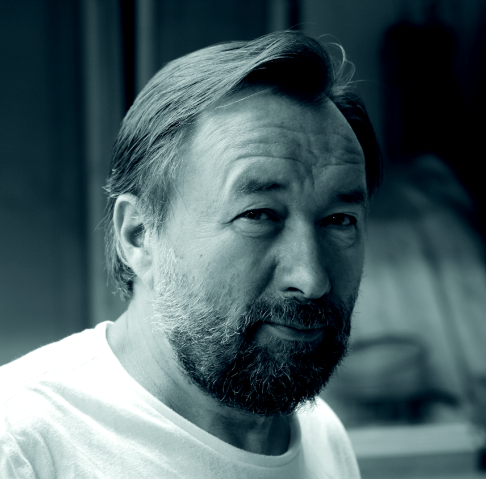
Peter Nižňanský
Peter Nižňanský - born in 1956 in Dunajská Streda. He graduated from the School of Art Industry in Bratislava. From 1978 to 1984 he studied at the Academy of Fine Arts in Prague, and in 1981 he completed an internship in Berlin at the Hochschule der Künste. He lives and works in Prague and devotes himself to monumental and chamber sculpture, as well as restoration and medallic works. He has participated in numerous sculpture symposia in the Czech Republic and Slovakia, and has dozens of solo and group exhibitions to his credit. His works are in numerous public and private collections at home and abroad.
Peter Nižňanský is a sculptor with a strong humanistic sensibility. His black horseman, who descended from the heavens into the world after breaking the third seal, flies like a whirlwind through the country and brings hunger to the desolate and scorched earth. The author portrayed his rider and horse in a unique moment of movement with his cloak spread open, clearly aware that the measure used to divide barley and wheat into daily wages, which he carries on his shoulder instead of symbolic scales, is long since empty and only death follows him. He sees this figure as a metaphor for the devastated countries that can be found in many places on our globe in the 21st century. He developed this dark motif with full force in his compelling and passionate sketch of the Black Rider.
Peter Nižňanský is a sculptor with a strong humanistic sensibility. His black horseman, who descended from the heavens into the world after breaking the third seal, flies like a whirlwind through the country and brings hunger to the desolate and scorched earth. The author portrayed his rider and horse in a unique moment of movement with his cloak spread open, clearly aware that the measure used to divide barley and wheat into daily wages, which he carries on his shoulder instead of symbolic scales, is long since empty and only death follows him. He sees this figure as a metaphor for the devastated countries that can be found in many places on our globe in the 21st century. He developed this dark motif with full force in his compelling and passionate sketch of the Black Rider.


